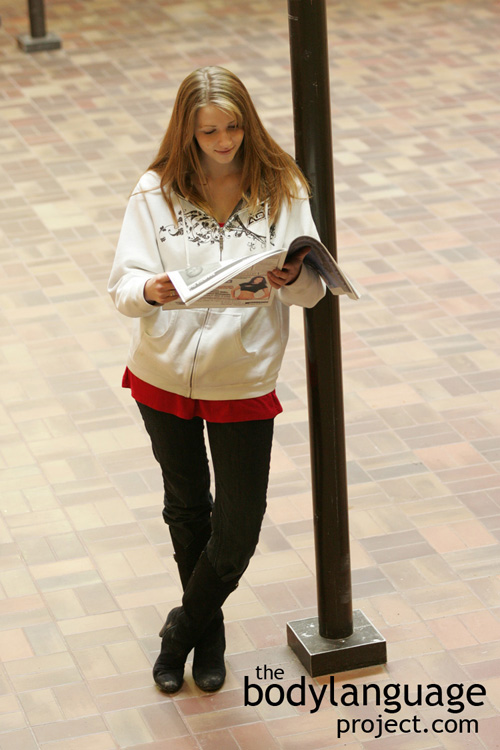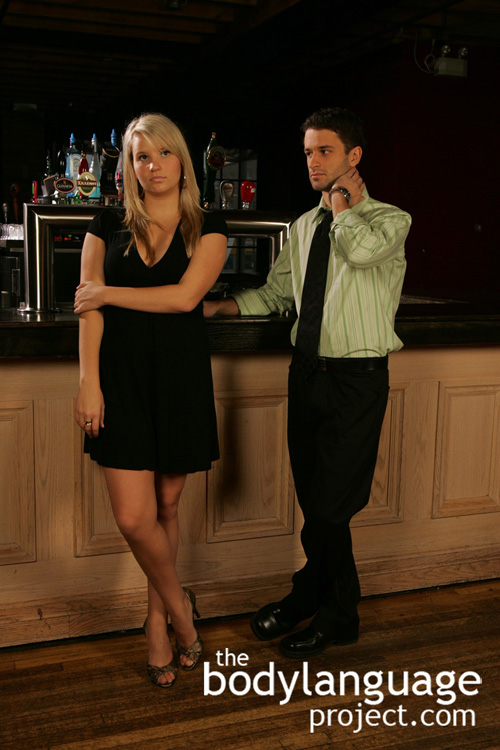Body Language of Cocooning
Synonym(s): Rolling Into A Ball, Curling Up, Slumping, Putting On Headphones, Texting In Public, Reading A Book In Public.
Description: There are various degrees of cocooning including putting on headphones, putting up the hands to the side of the face, collapsing the head onto the thighs in a seated position.
In One Sentence: Cocooning is to collapse in one ones-self and indicates the desire to protect and recoil from outside harm.
How To Use it: Use this gesture to show others that you are unwell and that you want to gain their sympathy. When you are depressed, coiling up can help you feel safe and protected from the outside world. Onlookers will immediately spot your discomfort and offer sympathy, care, special assistance, or time alone to reflect.
When in busy locations, a set of headphones or reading material can help drown out the outside world permitting one internal reflection. This too is a form of cocooning. When these are not available, allowing the eyes to glaze over can also allow one to escape and reflect.
Context: General.
Verbal Translation: a) “Leave me be, I have my headphones on because I just want to be left alone.” b) “I’m thinking about something, I’m not stressed, but I need a moment to ponder something c) “I’m really upset and feeling bad. I’m grieving and I’m really at a loss for words, I may or may not want some comforting.”
Variant: See Shoulder Shrugs or Shoulder Rise, Body Lowering, Fetal Position (The).
Cue In Action: a) While shopping for groceries, Brenda put her headphones on so she wouldn’t have to talk to anyone. b) When asked if she wanted the chicken or fish, she put her hands on the side of her face and thought to herself. c) When told that her father was sick and was certain to pass way, she collapsed; stricken with grief.
Meaning and/or Motivation: Cocooning indicates that concentration is required, a person is experiencing stress or that a person is emotionally withdrawn and requires escape. Other times, a person cocoons as a way to establish privacy in a public setting when they need time to thing and recover from excess stimulation.
Cocooning is a term used to describe body language that indicates a desire not to be bothered. There are various degrees which include a mild form such as putting on headphones to tell others that social interaction is undesired, putting up the hands to the side of the face while studying (mild cocooning), and an extreme form where the head collapses onto the thighs in a seated position which can indicate grieving.
Cue Cluster: Cocooning is usually accompanied by slumped shoulders, hands to face, eyes, or ear, hand to head in a helmet or protective type gesture. The body almost always slumps forward in a fetal position except in mild cocooning. A blank face is usually coupled with cocooning, but under extreme stress we see a grief expression where the brows come together. At times, there might be tears or sobbing.
Body Language Category: Body size reduction, Closed body language, Emotional body language, Low confidence body language, Negative body language, Protective reflexes, Orienting reflex or orienting response, Pensive displays, Stressful body language.
Resources:
Brin, Pablo and Oli Richard. Body Posture Effects On Self-Evaluation: A self-Validation Approach. European Journal of Social Psychology. 2009; 39: 1053–1064.
Blidstein, Gerald J. The Nonverbal Language of Prayer (review).Shofar: An Interdisciplinary Journal of Jewish Studies. 2007 25(2): 195-196.
Butzen, Nathan David ; Bissonnette, Victor ; Mcbrayer, Dan. Effects of modeling and topic stimulus on self-referent touching. Perceptual and motor skills. 2005. 101(2): 413-20.
Broome, Marion E.. Helping Parents Support Their Child In Pain. Pediatric Nursing. 2000. 26(3): 315.
Bouhuys, A.L. ; Jansen, C.J. ; van den Hoofdakker, R.H. Analysis of observed behaviors displayed by depressed patients during a clinical interview: relationships between behavioral factors and clinical concepts of activation. Journal of Affective Disorders. 1991. 21(2): 79-88.
Berridge CW,Mitton E, ClarkW, Roth RH. 1999. Engagement in a non-escape (displacement) behavior elicits a selective and lateralized suppression of frontal cortical dopaminergic utilization in stress. Synapse 32:187–197.
Caplovitz Barrett, Karen. The origins of social emotions and self-regulation in toddlerhood: New evidence. Cognition & Emotion. 2005. 19(7): 953-979.
Castles, Duncan L. ; Whiten, Andrew ; Aureli, Filippo. Social anxiety, relationships and self-directed behaviour among wild female olive baboons. Animal Behaviour. 1999. 58(6): 1207-1215.
Cashdan, Elizabeth. Smiles, Speech, and Body Posture: How Women and Men Display Sociometric Status and Power. Journal of Nonverbal Behavior. 1998. 22(4): 209-228.
Cardasis, W ; Hochman, J A ; Silk, K R. Transitional objects and borderline personality disorder. The American journal of psychiatry 1997, Vol.154(2), pp.250-5.
Cohen, Keith N. ; Clark, James A. Hogan, Robert (editor). Transitional object attachments in early childhood and personality characteristics in later life. Journal of Personality and Social Psychology. 1984. 46(1): 106-111.
D’alessio, M. ; Zazzetta, A. Development of Self-Touching Behavior in Childhood. Perceptual and Motor Skills. 1986. 63(1): 243-253.
Goldberg, Shelly ; Rosenthal, Robert. Self-touching behavior in the job interview: Antecedents and consequences. Journal of Nonverbal Behavior. 1986. 10(1): 65-80.
Ginsburg, Harvey J. ; Pollman, Vicki A. ; Wauson, Mitzi S. Odom, Richard D. (editor). An ethological analysis of nonverbal inhibitors of aggressive behavior in male elementary school children. Developmental Psychology. 1977 13(4): 417-418.
Harrison, Lynda Law. The use of comforting touch and massage to reduce stress for preterm infants in the neonatal intensive care unit. Newborn and Infant Nursing Reviews. 2001. 1(4): 235-241.
Harrigan, Jinni A. Self-touching as an indicator of underlying affect and language processes. Social Science & Medicine. 1985. 20(11): 1161-1168.
Heaven, Laura ; Mcbrayer, Dan ; Prince, Bob. Role of sex in externally motivated self-touching gestures. Perceptual and motor skills. 2002. 95(1): 289-94.
Heaven, L ; Mcbrayer, D. External motivators of self-touching behavior. Perceptual and motor skills. 2000. 90(1): 338-42.
Hyisung C. Hwang, David Matsumoto. Dominance threat display for victory and achievement in competition context. Motivation and Emotion, 2014.
Jessica L. Tracy and David Matsumoto. The Spontaneous Expression Of Pride And Shame: Evidence For Biologically Innate Nonverbal Displays. 2008; 105 (33) 11655-11660.
http://bodylanguageproject.com/articles/universal-expressions-of-pride-and-shame/
Katza, Carmit; Irit Hershkowitz; Lindsay C. Malloya; Michael E. Lamba; Armita Atabakia and Sabine Spindlera. Non-Verbal Behavior of Children Who Disclose or do not Disclose Child Abuse in Investigative Interviews. Child Abuse & Neglect. 2012. 36: 12-20.
http://bodylanguageproject.com/articles/reading-nonverbal-behaviour-child-abuse-cases-encourage-children-divulge-information-truth-telling
Lehman, E.B., Arnold, B.E., & Reeves, S.L. (1995). Attachments to blankets, teddy bears, and other nonsocial objects: A child’s perspective. The Journal of Genetic Psychology, 156(4), 443–459.
Lehman, E.B., Arnold, B.E., Reeves, S.L., & Steir, A. (1996). Maternal beliefs about children’s attachments to soft objects. American Journal of Orthopsychiatry, 66(3), 427–436.
Lehman, E.B., Denham, S., Moser, M.H., & Reeves, S.L. (1992). Soft object and pacifier attachments in young children: The role of security of attachment to the mother. Journal of Child Psychology and Psychiatry, 33(7), 1205–1215.
Lehman, E.B., Holtz, B.A., & Aikey, K.L. (1995). Temperament and self-soothing behaviour in children: Object attachment, thumbsucking, and pacifier use. Early Education and Development, 6(1), 53–72.
Liss, M., Timmel, L., Baxley, K., & Killingsworth, P. (2005). Sensory processing and its
relation to parental bonding, anxiety, and depression. Personality and Individual Differences, 39, 1429–1439.
Maestripieri D, Schino G, Aureli F, Troisi A. 1992. A modest proposal: displacement activities as an indicator of emotions in primates. Anim Behav 44:967–979.
Mohiyeddini, C., Bauer, S., & Semple, S. (2013a). Displacement behaviour is associated with reduced stress levels among men but not women. PLoS One, 8, e56355.
Mohiyeddini, C., Bauer, S., & Semple, S. (2013b). Public self-consciousness moderates the link between displacement behaviour and experience of stress in women. Stress, 16, 384–392.
Mohiyeddini, C., & Semple, S. (2013). Displacement behaviour regulates the experience of stress in men. Stress, 16, 163–171.
Marsh, Abigail A; Henry H. Yu; Julia C. Schechter and R. J. R. Blair. Larger than Life: Humans’ Nonverbal Status Cues Alter Perceived Size. PLoS ONE. 2009. 4(5): e5707. doi:10.1371/journal.pone.0005707. http://bodylanguageproject.com/articles/large-life-nonverbal-dominance-affects-perception-size/?preview=true
Matsumoto, David, Hyi Sung Hwang. Evidence For A Nonverbal Expression Of Triumph. Evolution and Human Behavior, 2012; 33 (5): 520-529. http://bodylanguageproject.com/articles/athletes-first-reaction-to-triumph-is-body-language-dominance-display/
Navarro, Joe. 2008. What Every BODY is Saying: An Ex-FBI Agent’s Guide to Speed-Reading People. William Morrow Paperbacks.
Park, Lora E.; Lindsey Streamer; Li Huang and Adam D. Galinsky. Stand Tall, But Don’t Put Your Feet Up: Universal and Culturally-Specific Effects of Expansive Postures On Power. Journal of Experimental Social Psychology. 2013; 49: 965–971.
http://bodylanguageproject.com/articles/are-expansive-postures-of-power-universal-or-cultural/
Riskind, John H. Manis, Melvin (editor). They stoop to conquer: Guiding and self-regulatory functions of physical posture after success and failure. Journal of Personality and Social Psychology. 1984 47(3): 479-493.
Sturman, Edward D. Invluntary Subordination and Its Relation to Personality, Mood,
and Submissive Behavior. Psychological Assessment. 2011. 23(1): 262-276 DOI: 10.1037/a0021499
http://bodylanguageproject.com/articles/nonverbal-submission-men-women-depression-critical-examination-use-disuse-submission/
Schino G, Perretta G, Taglioni AM, Monaco V, Troisi A. 1996. Primate displacement activities as an ethopharmacological model of anxiety. Anxiety 2:186–191.
Supplee, Lauren H ; Skuban, Emily Moye ; Shaw, Daniel S ; Prout, Joanna. Emotion regulation strategies and later externalizing behavior among European American and African American children. Development and Psychopathology. 2009. 21(2): 393-415.
Troisi A. 1999. Ethological research in clinical psychiatry: the study of nonverbal behaviour during interviews. Neurosci Biobehav Rev 23:905–913.
Troisi A. 2002. Displacement activities as a behavioral measure of stress in nonhuman primates and human subjects. Stress 5: 47–54.





